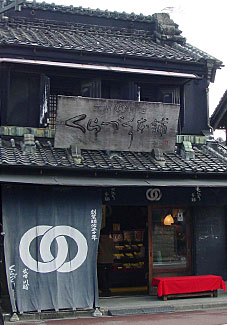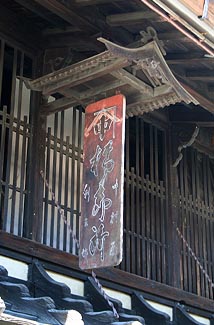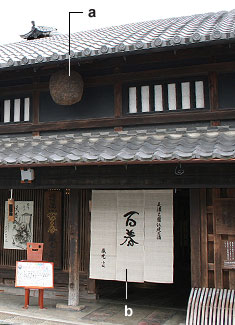A signboard
placed outside or affixed to the front of a commercial premises displaying
the name of the shop yagou 屋号, and the nature of the business. Special
variants in the case of theaters gekijou 劇場, might display the plays
currently being performed. Kanban appear to have developed in Japan
during the Edo period, for there are none in the late Muromachi illustrations
of urban scenes (such as the *rakuchuu
rakugai-zu 洛中洛外図). Instead curtains *noren
暖簾, in shop entrances were used to identify merchants' houses *machiya
町家 at that time. Sometimes the sign was applied directly to an architectural
element, such as a projecting gable parapet *udatsu
卯立 or the box holding the rain doors *tobukuro
戸袋, but the simplest Edo period, kanban were wooden boards with characters
painted or incised on them, which were suspended from the eaves of either
the main roof or the front roof *hisashi
廂, parallel or at right angle to the facade, or mounted on the hisashi
roof. Sometimes the board was given a decorative outline, related to the
nature of the business: a pot for a vinegar manufacturer, or a comb for
a comb-maker. In the latter half of the Edo period, more elaborate kanban
developed, taking the form of small roofed structures yakata 屋形,
and using elements of architecture usually associated with temples or shrines,
such as bracket systems *tokyou
斗きょう and cusped gables *karahafu
唐破風. These reflect the increasing prosperity of the merchant class. A more
abstract form of kanban were the balls of cedar needles sugidama
杉玉, suspended from the eaves of sake 酒 breweries sakaya 酒屋.
|





